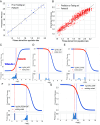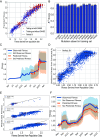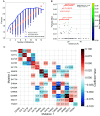Biophysical principles predict fitness of SARS-CoV-2 variants
- PMID: 38820002
- PMCID: PMC11161772
- DOI: 10.1073/pnas.2314518121
Biophysical principles predict fitness of SARS-CoV-2 variants
Abstract
SARS-CoV-2 employs its spike protein's receptor binding domain (RBD) to enter host cells. The RBD is constantly subjected to immune responses, while requiring efficient binding to host cell receptors for successful infection. However, our understanding of how RBD's biophysical properties contribute to SARS-CoV-2's epidemiological fitness remains largely incomplete. Through a comprehensive approach, comprising large-scale sequence analysis of SARS-CoV-2 variants and the identification of a fitness function based on binding thermodynamics, we unravel the relationship between the biophysical properties of RBD variants and their contribution to viral fitness. We developed a biophysical model that uses statistical mechanics to map the molecular phenotype space, characterized by dissociation constants of RBD to ACE2, LY-CoV016, LY-CoV555, REGN10987, and S309, onto an epistatic fitness landscape. We validate our findings through experimentally measured and machine learning (ML) estimated binding affinities, coupled with infectivity data derived from population-level sequencing. Our analysis reveals that this model effectively predicts the fitness of novel RBD variants and can account for the epistatic interactions among mutations, including explaining the later reversal of Q493R. Our study sheds light on the impact of specific mutations on viral fitness and delivers a tool for predicting the future epidemiological trajectory of previously unseen or emerging low-frequency variants. These insights offer not only greater understanding of viral evolution but also potentially aid in guiding public health decisions in the battle against COVID-19 and future pandemics.
Keywords: SARS-CoV-2; antibody; fitness landscape; receptor binding domain; viral evolution.
Conflict of interest statement
Competing interests statement:The authors declare no competing interest.
Figures




Update of
-
Biophysical principles predict fitness of SARS-CoV-2 variants.bioRxiv [Preprint]. 2024 Jan 22:2023.07.23.549087. doi: 10.1101/2023.07.23.549087. bioRxiv. 2024. Update in: Proc Natl Acad Sci U S A. 2024 Jun 4;121(23):e2314518121. doi: 10.1073/pnas.2314518121. PMID: 37577536 Free PMC article. Updated. Preprint.
Comment in
-
The biophysical landscape of viral evolution.Proc Natl Acad Sci U S A. 2024 Jul 2;121(27):e2409667121. doi: 10.1073/pnas.2409667121. Epub 2024 Jun 24. Proc Natl Acad Sci U S A. 2024. PMID: 38913906 Free PMC article. No abstract available.
References
MeSH terms
Substances
Supplementary concepts
Grants and funding
LinkOut - more resources
Full Text Sources
Medical
Miscellaneous

